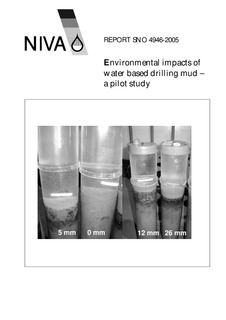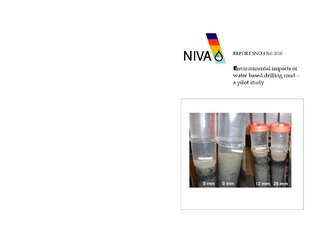| dc.contributor.author | Schaanning, M. | nb_NO |
| dc.contributor.author | Øxnevad, S. | nb_NO |
| dc.contributor.author | Uriansrud, F. | nb_NO |
| dc.contributor.other | Schaanning, M. - Project manager | nb_NO |
| dc.date.accessioned | 2014-08-01T10:49:19Z | |
| dc.date.available | 2014-08-01T10:49:19Z | |
| dc.date.issued | 2005 | nb_NO |
| dc.identifier | 4946 | nb_NO |
| dc.identifier.isbn | 82-577-4639-8 | nb_NO |
| dc.identifier.issn | 1894-7948 | nb_NO |
| dc.identifier.uri | http://hdl.handle.net/11250/212704 | |
| dc.description | Årsliste 2005 | nb_NO |
| dc.description.abstract | A pilot test on waterbased drilling mud has been performed at NIVAs Marine Research Station at Solbergstrand. 15 cores with different thickness of drill cuttings were incubated for a period of 25 days, during which O2 consumption and nutrient fluxes (NO3 and SiO2) were determined and microgradients studied using microelectrodes and a DGT (Diffusive Gradients in Thin-films) -probe. The results showed peak consumption of O2 2-15 days after addition of the cuttings. Maximum O2 consumption was about three times higher than untreated control sediments. A general correlation was found between thickness of the cuttings layer and consumption of O2 and NO3. Release of silicate, however, decreased in cores with layers exceeding 3-5 mm. The microelectrode showed no H2S in the core investigated, but compared to untreated control sediments, the cuttings had reduced oxygen penetration from 5 to 3 mm depth and lowered redox potentials in the anoxic layer from ca 200 to ca 80 mV. The DGT-gradients indicated upwards diffusion of iron (Fe), lead (Pb) and barium (Ba). Fe was retained in the sediment by oxidation and precipitation at the lower boundary of the oxic layer. No evidence was found for any release of metals from the cuttings added. The recommendation for the EXPAC project was that in order to avoid severe effects of hydrogen sulphide toxicity and smothering, it is recommended not to use doses exceeding 3 mm layer thickness. | nb_NO |
| dc.description.sponsorship | Akvaplan-NIVA | nb_NO |
| dc.publisher | Norsk institutt for vannforskning | nb_NO |
| dc.relation.ispartofseries | NIVA-rapport;4946 | nb_NO |
| dc.rights | Navngivelse-IkkeKommersiell-DelPåSammeVilkår 3.0 Norge | nb_NO |
| dc.rights.uri | http://creativecommons.org/licenses/by-nc-sa/3.0/no/ | nb_NO |
| dc.subject | miljøgifter - marint | nb_NO |
| dc.title | Environmental impacts of water based drilling mud - a pilot study | nb_NO |
| dc.type | Research report | nb_NO |
| dc.rights.holder | Norsk institutt for vannforskning/Norwegian institute for water research | nb_NO |
| dc.subject.nsi | VDP::Matematikk og naturvitenskap: 400 | nb_NO |
| dc.source.pagenumber | 24 | nb_NO |
| dc.subject.keyword | borekaks | nb_NO |
| dc.subject.keyword | marine sedimenter | nb_NO |
| dc.subject.keyword | miljøpåvirkning | nb_NO |
| dc.subject.keyword | flukser | nb_NO |
| dc.subject.keyword | environmental effects | nb_NO |
| dc.subject.keyword | drilling | nb_NO |
| dc.subject.keyword | mud | nb_NO |
| dc.subject.keyword | marine | nb_NO |
| dc.subject.keyword | sediments | nb_NO |
| dc.subject.keyword | nutrients | nb_NO |
| dc.subject.keyword | fluxes | nb_NO |
| dc.relation.project | O-24073 | nb_NO |


